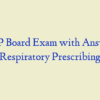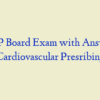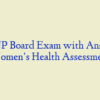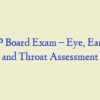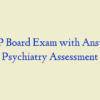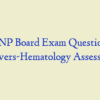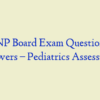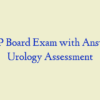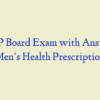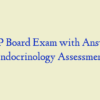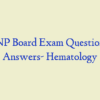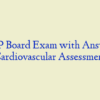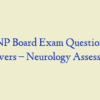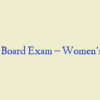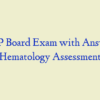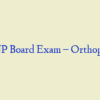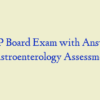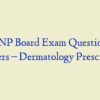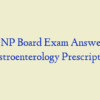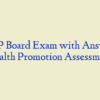Description
AGNP BOARD EXAM QUESTIONS Prescription of Endocrinology (89 Questions and Answers)
- When patients administer regular insulin (Humulin R U-500), they should be taught:
- Patients taking thiazolidinedione (TZD) medications should be monitored for:
- A patient diagnosed with Type 2 diabetes mellitus has an initial hemoglobin A1C of 7.2%. Assuming no contraindications, the American Diabetes Association’s (ADA) initial recommendation for this patient includes:
- Gynecomastia is NOT likely to be caused by:
- Which of the following medications may cause gynecomastia?
- Sodium-glucose co-transporter 2 (SGLT2) inhibitors reduce blood glucose by:
- A patient who is started on a glucagon-like peptide (GLP-1), such as Victoza, should be informed that this class of medications may:
- The most frequent side effect of metformin (Glucophage) is:
- Patients taking dipeptidyl-peptidase-4 (DDP-IV) inhibitors for the treatment of Type 2 diabetes do NOT routinely need to be monitored for:
- A patient who has Addison’s disease has received a prescription for fludrocortisone. Fludrocortisone acts by:
- A 63-year-old woman with Type 2 diabetes mellitus has been treated with metformin (Glucophage) for the past 3 months. Baseline estimated glomerular filtration rate was 63. Renal function on this patient should be checked:
- Because of the mechanism of action, patients should be instructed to administer exenatide (Byetta):
- A patient has type 2 diabetes and takes NPH insulin. If his blood glucose values are elevated before the evening meal, when should additional NPH insulin be given?
- Which of the following is a rapid-acting insulin?
- Pioglitazone hydrochloride (Actos) is contraindicated in patients with:
- A patient who has Type 2 diabetes has a history of heart failure. He takes aspart (NovoLog) daily. Which drug class, in combination with Novolog, will significantly increase his risk of heart failure?
- A 48-year-old patient is started on metformin (Glucophage) for Type 2 diabetes (T2DM). The maximum expected hemoglobin A1C reduction after initiation of this medication is:
- Signs and symptoms of hypoglycemia may be blunted by:
- Patients receiving atenolol (Tenormin) for symptomatic management of hyperthyroidism should be advised that:
- A patient is receiving a fast-acting insulin to decrease post-prandial blood sugars.
- If the bedtime blood sugar is elevated, the patient should be advised to increase the fast-acting insulin dose at:
- Prior to the administration of methimazole (Tapazole), the nurse practitioner should obtain a baseline:
- Sulfonylureas such as glyburide (Micronase) are extensively metabolized:
- Which of the following medication classes should be avoided in patients with Type 2 diabetes mellitus and a comorbidity of moderate to severe heart failure?
- Insulin detemir (Levemir):
- Patients receiving insulin detemir (Levemir) are at higher risk for developing:
- The medication that provides the greatest potential reduction in hemoglobin A1C levels is:
- Synthroid is a thyroid medication used to treat hypothyroidism. It contains a synthetic form of:
- Alpha-glucosidase inhibitors such as acarbose (Precose) are contraindicated in patients with:
- Patients who use insulin glargine (Lantus) should be advised:
- A patient who has Type 2 diabetes has consistently elevated blood sugars before lunch. When should a fast-acting insulin be added to this patient’s regimen?
- Insulins recommended for use in insulin pump delivery systems include:
- Radioactive iodine treatment for the permanent treatment of hyperthyroidism is usually administered:
- In addition to hemoglobin A1C, patients receiving metformin (Glucophage) should be monitored for:
- Which of the following patients would be at risk for lactic acidosis secondary to metformin (Glucophage) use?
- Which of the following side effects may be caused by methimazole (Tapazole)?
- Thiazolidinedione (TZD) medications:
- Patients who are receiving radioiodine therapy for hyperthyroidism should be advise to:
- A patient is started on a sulfonylurea (i.e., glyburide). The nurse practitioner informs the patient that sulfonylureas are likely to:
- Radioiodine therapy is safe to administer to:
- Undertreatment of hypothyroidism in pediatric patients may lead to:
- Methimazole for the treatment of Graves’ disease is contraindicate in patients:
- The onset of action of short-acting insulins is:
- A 35-year-old woman with Type 2 diabetes mellitus has taken 1000 mg metformin twice daily for the past 3 months. Today’s hemoglobin A1C has decrease to 7.8%. An appropriate action today is to:
- A patient with Graves’ hyperthyroidism is start on thionamide therapy (methimazole [Tapazole]). The goal is to achieve a euthyroid state within:
- Alpha-glucosidase inhibitors help to lower serum glucose by:
- An example of a medication that contains a combination of a sulfonylurea and biguanide is:
- The expected hemoglobin A1C reduction for patients who are started on a dipeptidyl peptidase-4 (DPP-4) inhibitor such as sitagliptin (Januvia) is:
- Metformin (Glucophage) is a:
- Which of the following medications is NOT a potential cause of gynecomastia?
- The generic name for Victoza is:
- DPP IV inhibitors such as alogliptin (Nesina):
- The mechanism of action of methimazole (Tapazole) is to:
- Victoza (liraglutide), a glucagon-like peptide-1 for the treatment of Type 2 diabetes, may potentially decrease the effectiveness of:
- Which of the follow is an intermediate-acting insulin?
- A 55-year-old obese woman with Type 2 diabetes mellitus has been receiving metformin and glimepiride daily at highest tolerate doses. Her most recent hemoglobin A1C is 9.0%. How should this be manage?
- Joe is a 50-year-old diabetic. He took Humulin R-100 6 hours ago, prior to lunch. He is now going to work out. With regard to hypoglycemia during exercise, Joe should:
- Aspart (NovoLog) should be administer:
- Levothyroxine use in the first trimester of pregnancy:
- A 32-year-old woman is diagnose with hyperthyroidism. The nurse practitioner knows that initiating a beta-blocker:
- Trulicity (dulaglutide) a glucagon-like peptide-1, would be indicate for use in which of the follow patients?
- Sulfonylureas such as glyburide (Diabeta) are expect to reduce the hemoglobin A1C in patients with Type 2 diabetes mellitus by:
- Maximum plasma concentrations of glucagon, after intramuscular injection, are observe in approximately:
- In addition to hypoglycemia, rapid-acting insulins may cause:
- The most common serious side effect associate with glimepiride (Amaryl) is:
- A patient is start on exenatide (Byetta) for Type 2 diabetes. Byetta should be discontinue if the patient exhibits:
- Glyburide (Diabeta) is a:
- Many medications can enhance the hypoglycemic effect of sulfonylureas. Which medication class does NOT enhance the hypoglycemic effect of sulfonylureas?
- The mechanism of action by which metformin (Glucophage) improves glucose tolerance is:
- Thiazolidinediones (TZDs) such as pioglitazone (Actos) reduce A1C by levels by:
- Levothyroxine (Synthroid) is indicate in the treatment of:
- Lantus is:
- Sulfonylurea agents such as glimepiride (Amaryl):
- Insulin glargine (Lantus) is NOT indicate in the treatment of:
- What are the benefits of initiating an alpha-glucosidase inhibitors such as acarbose (Precose) for a patient with Type 2 diabetes?
- Exenatide (Byetta) is classified as:
- Sodium-glucose co-transporter 2 (SGLT2) inhibitors are oral antidiabetic agents and are known to cause:
- The mechanism of action for glucagon-like peptide-1 (GLP-1) medications like Byetta, Victoza, Trulicity and others is:
- Glucagon should be administer to the patient who has severe hypoglycemia secondary to:
- The combination of metformin (Glucophage) and glyburide (Diabeta) for the treatment of Type 2 diabetes is:
- hich of the follow is a short-acting insulin?
- Which statement about metformin (Glucophage) is correct?
- Levothyroxine (Synthroid) is best administer:
- Patients should be advise to take glimepiride (Amaryl):
- Due to the mechanism of action of meglitinides use in the treatment of Type 2 diabetes, they should be administer:
- Levothyroxine (Synthroid) would NOT be indicate for the treatment of:
- The most commonly report side effect of the GLP-1 medication class is:
- Insulin promotes the absorption of glucose from the blood in many tissues/organs of the body. In which tissue/organ does this NOT occur?
- Regular insulin (Novolin R) should be administer:

